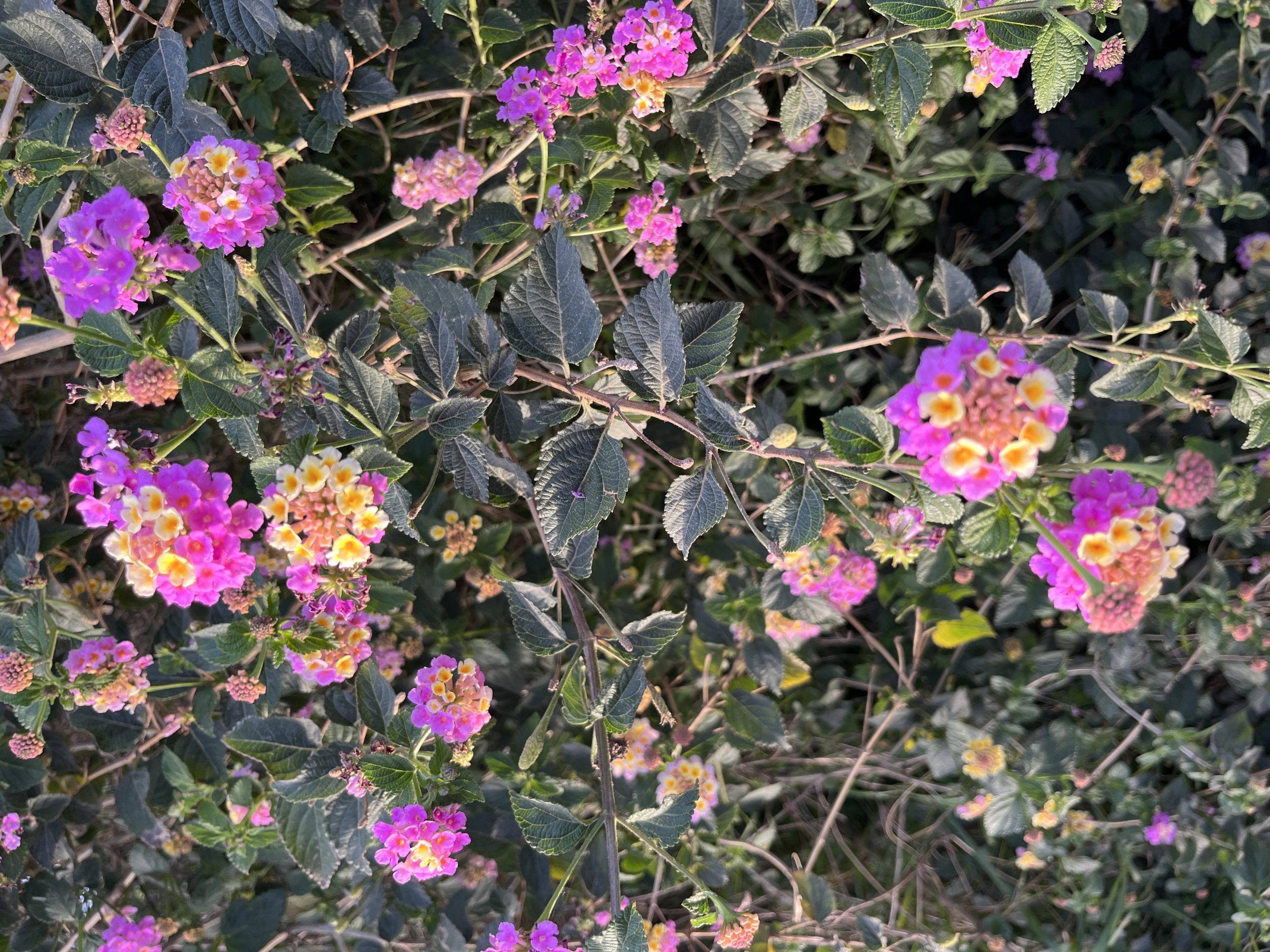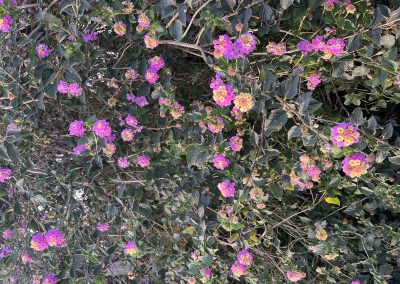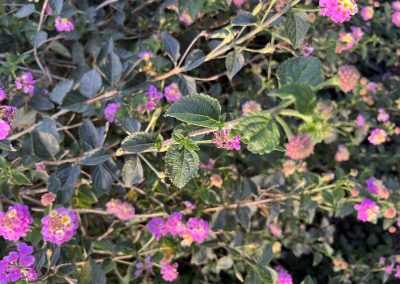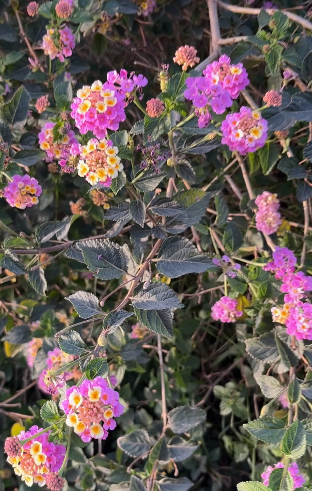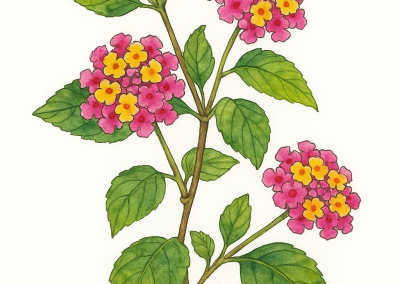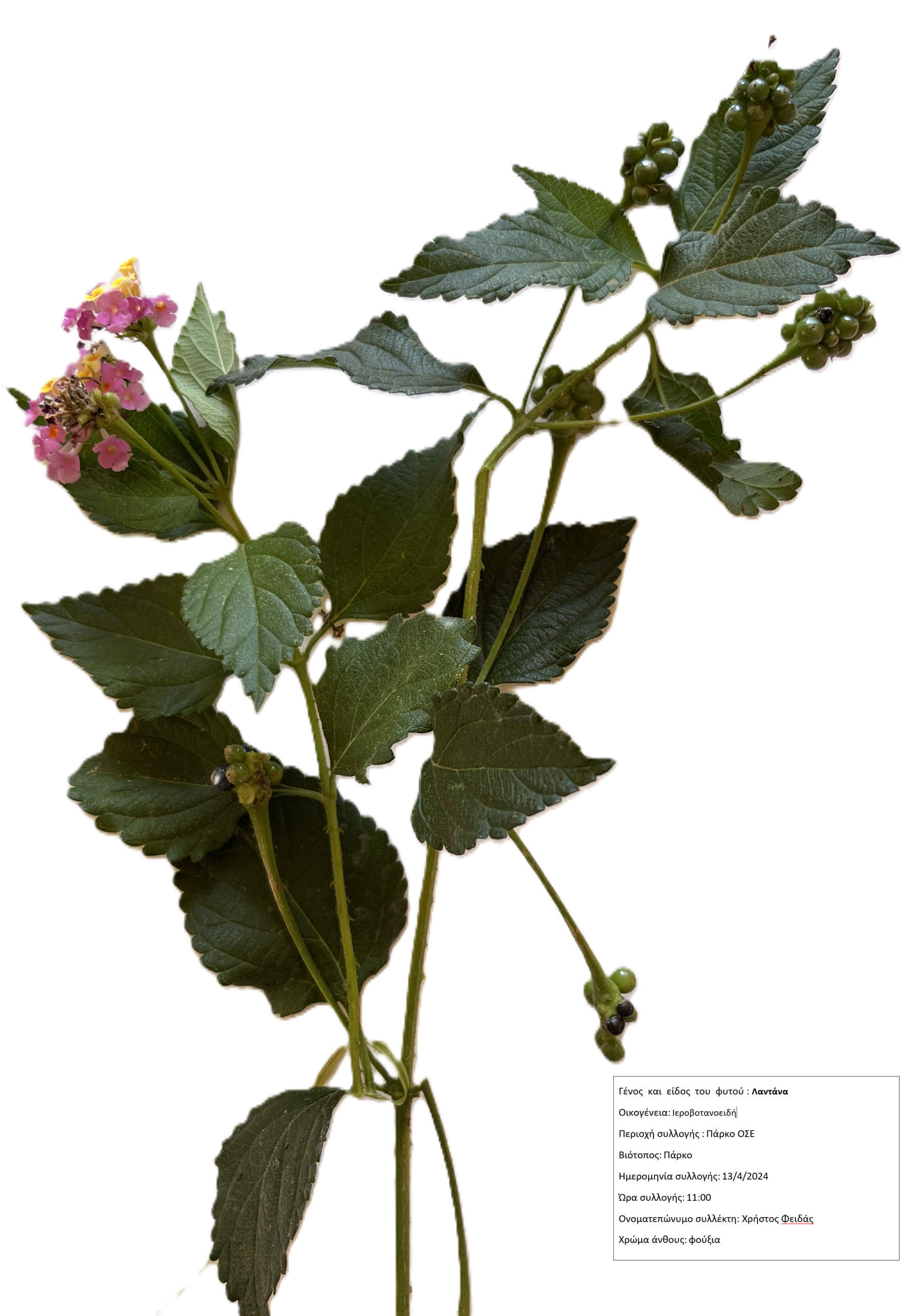Lantana
Scientific description
Scientific name: Lantana (Lantana camara, Lantana montevidensis)
Kingdom: Plantae
Phylum: Magnoliophyta
Class: Magnoliopsida
Order: Lamiales
Family: Verbenaceae
Genus: Lantana
Origin:
Native to tropical regions of America and Africa; introduced in many regions, especially Australia-Pacific, southern and northeastern India. Name derives from Late Latin, referring to Viburnum lantana.
Description:
Erect, semi-evergreen, fast-growing ornamental shrub with dense vegetation and contrasting, fuzzy, serrated leaves. Height and width 1.5–3 m; reaches final size in 5–10 years. Dense, tufted foliage on thin, woody, slightly spindly branches; dark green, wrinkled, “hairy” leaves; remains green all year. Colorful flowers appear late spring through fall in clusters resembling strange daisies, colors red, orange, yellow, white, fuchsia, pink. Flowers ripen to fruits, red or bright blue-black.
Propagation:
By seed and cuttings.
Ecology:
Some species invasive; considered noxious weeds in South Asia, South Africa, Australia. Naturalized in Southeast USA (Carolinas, Georgia, Florida, Gulf coast). Leaves toxic to most animals; fruits eaten by birds which disperse seeds and degrade native ecosystems.
Uses:
Grown for ornamental flowers in tropical/subtropical areas and as annual in temperate climates. Useful as honey plants (L. camara, L. lilacina, L. trifolia). Fruits disputed as edible; may be mildly poisonous if green, potentially deadly if experimental research considered. Extracts of L. camara protect cabbage from aphid Lipaphis erysimi.
Επιστημονική ονομασία: Λαντάνα (Lantana camara, Lantana montevidensis)
Βασίλειο: Φυτά (Plantae)
Συνομοταξία: Αγγειόσπερμα (Magnoliophyta)
Ομοταξία: Δικοτυλήδονα (Magnoliopsida)
Τάξη: Λαμιώδη (Lamiales)
Οικογένεια: Ιεροβοτανοειδή (Verbenaceae)
Γένος: Λαντάνα
Καταγωγή:
Ιθαγενείς σε τροπικές περιοχές Αμερικής και Αφρικής, εισαγόμενοι σε πολλές περιοχές (Αυστραλία-Ειρηνικός, νότια και βορειοανατολική Ινδία). Το όνομα προέρχεται από ύστερη Λατινική, αναφέρεται στο Viburnum lantana.
Περιγραφή:
Ορθόκλαδος, ημιαειθαλής θάμνος, γρήγορης ανάπτυξης, πυκνή βλάστηση, αντίθετα, χνουδωτά, οδοντωτά φύλλα. Ύψος/πλάτος 1,5–3 m, τελικό μέγεθος σε 5–10 χρόνια. Πυκνό, φουντωτό φύλλωμα σε λεπτά, ξυλώδη κλαδιά, σκούρα πράσινα, ζαρωμένα, τριχωτά φύλλα, πράσινα όλο το χρόνο. Πολύχρωμα άνθη αργά άνοιξη–φθινόπωρο σε μπουκετάκια, χρώματα κόκκινο, πορτοκαλί, κίτρινο, λευκό, φούξια, ροζ. Άνθη ωριμάζουν σε καρπούς, κόκκινοι ή μπλε-μαύροι.
Πολλαπλασιασμός:
Με σπόρους και μοσχεύματα.
Οικολογία:
Ορισμένα είδη χωροκατακτητικά, επιβλαβή ζιζάνια σε Ν. Ασία, Ν. Αφρική, Αυστραλία. Στις ΗΠΑ, φυσικοποιημένη στα νοτιοανατολικά (Καρολίνα, Τζόρτζια, Φλόριντα, Κόλπος Μεξικού). Φύλλα δηλητηριώδη για ζώα, καρποί τρώγονται από πουλιά που διασπείρουν σπόρους και επηρεάζουν οικοσυστήματα.
Χρήσεις:
Καλλιεργείται για άνθη σε τροπικά/υποτροπικά περιβάλλοντα και ως ετήσιο σε εύκρατα κλίματα. Μελιτοφόρα φυτά (L. camara, L. lilacina, L. trifolia). Βρωσιμότητα καρπών αμφιλεγόμενη· πράσινοι ελαφρώς δηλητηριώδεις, δυνητικά θανατηφόροι. Εκχυλίσματα L. camara προστατεύουν λάχανο από αφίδα Lipaphis erysimi.
Nom scientifique: Lantana (Lantana camara, Lantana montevidensis)
Règne: Plantae
Taxonomie: Magnoliophyta
Classe: Magnoliopsida
Ordre: Lamiales
Famille: Verbenaceae
Genre: Lantana
Origine:
Originaires des régions tropicales d’Amérique et d’Afrique; introduits dans de nombreuses régions, surtout Australie-Pacifique et sud/nord-est de l’Inde. Nom dérivé du latin tardif pour Viburnum lantana.
Description:
Arbuste ornemental dressé, semi-persistant, croissance rapide, végétation dense, feuilles opposées, duveteuses, dentées, odorantes. Taille 1,5–3 m, atteint taille adulte en 5–10 ans. Feuillage dense sur branches fines, ligneuses; feuilles vert foncé, gaufrées, poilues; reste vert toute l’année. Fleurs colorées, fin printemps–automne, grappes ressemblant à marguerites étranges, couleurs rouge, orange, jaune, blanc, fuchsia, rose; deviennent fruits rouge ou bleu-noir brillant.
Propagation:
Par graines et bouturage.
Écologie:
Certaines espèces envahissantes et nuisibles en Asie du Sud, Afrique du Sud, Australie. Naturalisation sud-est USA (Caroline, Géorgie, Floride, Golfe du Mexique). Feuilles toxiques pour animaux, fruits mangés par oiseaux, dispersent graines et impactent écosystèmes.
Utilisations:
Cultivé pour fleurs en climat tropical/subtropical et annuel en tempéré. Plantes mellifères (L. camara, L. lilacina, L. trifolia). Fruits discutés, verts légèrement toxiques, potentiellement mortels; extraits de L. camara protègent chou contre Lipaphis erysimi.
Denumire științifică: Lantana (Lantana camara, Lantana montevidensis)
Regn: Plantae
Sintaxă: Magnoliophyta
Clasă: Magnoliopsida
Ordin: Lamiales
Familie: Verbenaceae
Gen: Lantana
Origine:
Regiuni tropicale ale Americii și Africii; introdusă în multe regiuni, mai ales Australia-Pacific și sud/nord-est India. Numele generic derivă din latina târzie pentru Viburnum lantana.
Descriere:
Arbust ornamental erect, semi-veșnic verde, creștere rapidă, vegetație densă, frunze contrastante, pufoase, zimțate, miros caracteristic. Dimensiuni 1,5–3 m, atinge dimensiunea finală în 5–10 ani. Frunziș dens pe ramuri subțiri, lemnoase; frunze verde închis, ridate, păroase; verde tot anul. Flori colorate, sfârșit primăvară–toamnă, ciorchini tip margaretă, culori roșu, portocaliu, galben, alb, fuchsia, roz; devin fructe roșii sau albastru-negru.
Înmulțire:
Prin semințe și butași.
Ecologie:
Unele specii invazive și dăunătoare (Asia de Sud, Africa de Sud, Australia). Naturalizată în sud-est SUA (Carolina, Georgia, Florida, Golful Mexic). Frunze otrăvitoare pentru animale; fructe consumate de păsări care dispersează semințe și afectează ecosisteme.
Utilizări:
Cultivată pentru flori în medii tropicale/subtropicale și anual în climate temperate. Plante melifere (L. camara, L. lilacina, L. trifolia). Fructele disputate, verzi ușor toxice, potențial mortale; extracte de L. camara protejează varza de afida Lipaphis erysimi.
Creative writing inspired by Lantana
Lantana
Once, in a distant kingdom filled with exotic flowers and lush forests, lived a young princess named Lantana. She was known for her beauty, which resembled the vibrant blossoms that adorned the palace gardens. Lantana had a rare gift: she could communicate with plants and trees, nurturing them and making them bloom in every corner of her kingdom.
However, there was something unique about Lantana: her soul was as colorful as the flowers she grew, but she carried a deep fear. She was afraid of losing her beauty and withering away, just as the flowers wilt with the passing of time. Every day, she watched the blooms rise and fade, and the thought filled her with sorrow.
One day, while walking through the palace gardens, a mysterious old woman appeared before her. The woman, with wisdom in her eyes, said to Lantana, "Princess, I know your fear. You are afraid of change and losing your beauty, but flowers are not afraid to change. If you wish to keep your beauty forever, you must learn their secret."
Curious, Lantana asked the old woman to reveal the secret of eternal beauty. The woman told her that true beauty lies in the ability to change and adapt, just as flowers do. "There is a flower," the woman said, "that can change colors and bloom even in the harshest conditions. If you find this flower and understand its truth, then your beauty will be eternal."
Lantana set off on a long journey to find this magical flower. She traveled through jungles, deserts, and mountains until one day she arrived in a distant valley. There, she discovered a plant with small blossoms that changed colors from yellow to orange and pink – the Lantana. This plant, resilient in all conditions, bloomed continuously, no matter the heat or drought.
As the princess gazed upon the multicolored flowers of the Lantana, she realized that change is a natural part of life and that beauty never fades but transforms, just like the colors of the plant’s blooms. She returned to her kingdom and planted the Lantana in her gardens, reminding everyone that true beauty lies in the strength to adapt and embrace change.
From then on, the Lantana plant became a symbol of resilience and beauty, admired not just for its colors but for the lesson it taught the princess and all those who feared change.


